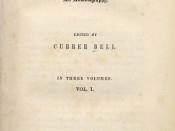In Jane Eyre, Charlotte Bronte portrays one woman's desperate struggle to attain her
identity in the mist of temptation, isolation, and impossible odds. Although she processes
a strong soul she must fight not only the forces of passion and reason within herself ,but
other's wills constantly imposed on her. In its first publication, it outraged many for its
realistic portrayal of life during that time. Ultimately, the controversy of Bronte's novel
lied in its realism, challenging the role of women, religion, and mortality in the
Victorian society.
In essence, Bronte's novel became a direct assault on Victorian morality. Controversy
based in its realistic exposure of thoughts once considered improper for a lady of the
19th century. Emotions any respectable girl would repress. Women at this time were not
to feel passion, nor were they considered sexual beings. To conceive the thought of
women expressing rage and blatantly retaliating against authority was a defiance against
the traditional role of women.
Jane Eyre sent controversy through the literary
community. For not only was it written by a woman but marked the first use of realistic
characters. Jane's complexity lied in her being neither holy good nor evil. She was poor
and plain in a time when society considered 'an ugly woman a blot on the face of
creation.' It challenged Victorian class structure in a strictly hierachal society. A
relationship between a lowly governess and a wealthy nobleman was simply unheard of.
Bronte drew criticism for her attack on the aristocracy who she deemed as hypocritical
'showy but ... not genuine.' She assaulted individual's already established morals by
presenting a plausible case for bigamy. Notions which should have evoked disgust and
outrage from its reader. Yet its most scandaless aspect was its open treatment of love.
Passionate love scenes which were...


